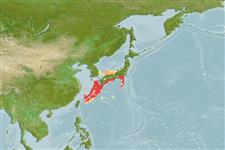Environment: milieu / climate zone / depth range / distribution range
Ökologie
seewasser bathydemersal; standorttreu; tiefenbereich 200 - 720 m (Ref. 1371). Deep-water; 37°N - 23°N, 124°E - 140°E (Ref. 1371)
Northwest Pacific: southern Japan and the East China Sea. Recently recorded from northeastern Taiwan (Ref. 54421).
Size / Gewicht / Alter
Maturity: Lm ? range ? - ? cm
Max length : 21.0 cm TL Männchen/unbestimmt; (Ref. 1371)
Rückenflossenstacheln (insgesamt): 2; Afterflossenstacheln 0. Snout short, blunt; terminal and lateral scutes large, blunt; undersides of snout, mandible, most of the suborbital, and part of the lower margin of the preopercle naked. Body scales with sharp, slender spinules in 4 to 16 parallel rows. Pyloric caeca 25 to 28. Overall color is brown; abdomen bluish; gill membranes blackish; fins dusky, first dorsal fin blackish distally; oral and branchial linings blackish.
Uncommon in depths shallower than 400 m. Frequents waters of 5-7°C. Polychaetes and euphausiids compose 30-60% of the diet of specimens from Japan, and prawns of minor importance.
Life cycle and mating behavior
Geschlechtsreife | Fortpflanzung | Ablaichen | Eier | Fecundity | Larven
Cohen, D.M., T. Inada, T. Iwamoto and N. Scialabba, 1990. FAO species catalogue. Vol. 10. Gadiform fishes of the world (Order Gadiformes). An annotated and illustrated catalogue of cods, hakes, grenadiers and other gadiform fishes known to date. FAO Fish. Synop. 125(10). Rome: FAO. 442 p. (Ref. 1371)
IUCN Rote Liste Status (Ref. 130435)
Bedrohung für Menschen
Harmless
Nutzung durch Menschen
Fischereien: weniger kommerziell
Mehr Information
NamenSynonymeMetabolismusRäuberÖkotoxikologieFortpflanzungGeschlechtsreifeAblaichenSpawning aggregationFecundityEierEientwicklung
ReferenzenAquakulturAquakultur ProfilZuchtlinienGenetikElectrophoresesVererbbarkeitKrankheitenVerarbeitungNutrientsMass conversion
Tools
Zusatzinformationen
Download XML
Internet Quellen
Estimates based on models
Preferred temperature (Ref.
123201): 8.6 - 15.7, mean 12.9 °C (based on 22 cells).
Phylogenetic diversity index (Ref.
82804): PD
50 = 0.5000 [Uniqueness, from 0.5 = low to 2.0 = high].
Bayesian length-weight: a=0.00219 (0.00111 - 0.00431), b=3.20 (3.03 - 3.37), in cm total length, based on LWR estimates for this (Sub)family-body shape (Ref.
93245).
Trophic level (Ref.
69278): 3.3 ±0.43 se; based on food items.
Widerstandsfähigkeit (Ref.
120179): mittel, Verdopplung der Population dauert 1,4 - 4,4 Jahre. (Preliminary K or Fecundity.).
Fishing Vulnerability (Ref.
59153): Low vulnerability (11 of 100).
